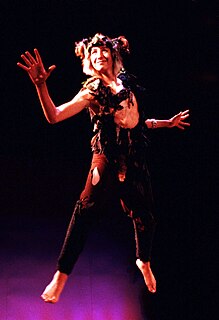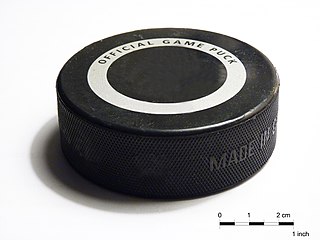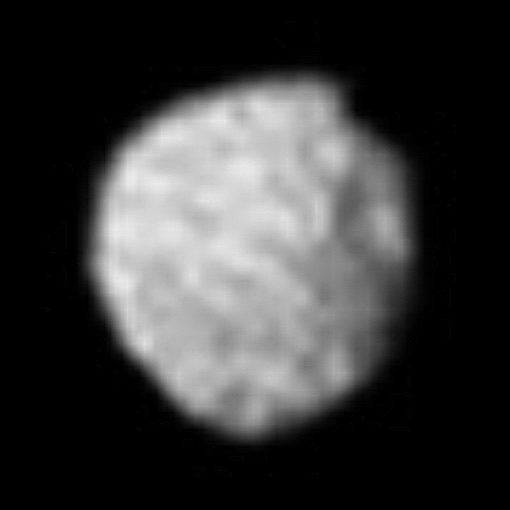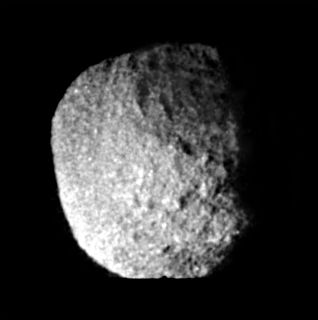
This is a list of named craters on Puck. Puckian craters are named after mischievous spirits in European mythology.
| Crater | Named after |
|---|---|
| Bogle | Bogle (Celtic) |
| Butz | Butz (German) |
| Lob | Lob (British) |

This is a list of named craters on Puck. Puckian craters are named after mischievous spirits in European mythology.
| Crater | Named after |
|---|---|
| Bogle | Bogle (Celtic) |
| Butz | Butz (German) |
| Lob | Lob (British) |

An impact crater is an approximately circular depression in the surface of a planet, moon, or other solid body in the Solar System or elsewhere, formed by the hypervelocity impact of a smaller body. In contrast to volcanic craters, which result from explosion or internal collapse, impact craters typically have raised rims and floors that are lower in elevation than the surrounding terrain. Impact craters range from small, simple, bowl-shaped depressions to large, complex, multi-ringed impact basins. Meteor Crater is a well-known example of a small impact crater on Earth.
Hockey is a sport in which two teams play against each other by trying to manoeuvre a ball or a puck into the opponent's goal using a hockey stick. There are many types of hockey such as bandy, field hockey, ice hockey and rink hockey.

Ice hockey is a contact team sport played on ice, usually in a rink, in which two teams of skaters use their sticks to shoot a vulcanized rubber puck into their opponent's net to score goals. The sport is known to be fast-paced and physical, with teams usually fielding six players at a time: one goaltender, and five players who skate the span of the ice trying to control the puck and score goals against the opposing team.
In English folklore, Puck, sometimes known as Robin Goodfellow, is a domestic and nature sprite, demon, or fairy.

Puck, also known as Robin Goodfellow, is a character in William Shakespeare's play A Midsummer Night's Dream, based on the ancient figure of Puck found in English mythology.

A hockey puck is a disk made of vulcanized rubber that serves the same functions in various games as a ball does in ball games. The best-known use of pucks is in ice hockey, a major international sport. A hockey puck has also been referred to as a "Flat Ball."

Puck is an inner moon of Uranus. It was discovered in December 1985 by the Voyager 2 spacecraft. The name Puck follows the convention of naming Uranus's moons after characters from Shakespeare. The orbit of Puck lies between the rings of Uranus and the first of Uranus's large moons, Miranda. Puck is approximately spherical in shape and has diameter of about 162 km. It has a dark, heavily cratered surface, which shows spectral signs of water ice.

Puck(

Proteus, also known as Neptune VIII, is the second-largest Neptunian moon, and Neptune's largest inner satellite. Discovered by Voyager 2 spacecraft in 1989, it is named after Proteus, the shape-changing sea god of Greek mythology. Proteus orbits Neptune in a nearly equatorial orbit at the distance of about 4.75 times the radius of Neptune's equator.
Brouwer is a Dutch and Flemish surname. The word brouwer means 'beer brewer'.

In ice hockey, a goal is scored when the puck entirely crosses the goal line between the two goal posts and below the goal crossbar. A goal awards one point to the team attacking the goal scored upon, regardless of which team the player who actually deflected the puck into the goal belongs to. Typically, a player on the team attempting to score shoots the puck with their stick towards the goal net opening, and a player on the opposing team called a goaltender tries to block the shot to prevent a goal from being scored against their team.

The centre in ice hockey is a forward position of a player whose primary zone of play is the middle of the ice, away from the sideboards. Centres have more flexibility in their positioning and are expected to cover more ice surface than any other player. Centres are ideally stronger, faster skaters who can back-check quickly from deep in the opposing zone. Generally, centres are expected to be gifted passers more than goal scorers, although there are exceptions. They are also expected to have exceptional "ice vision", intelligence, and creativity. They also generally are the most defensively oriented forwards on the ice. Centres usually play as part of a line of players that are substituted frequently to keep fresh and keep the game moving.

Winger, in the game of ice hockey, is a forward position of a player whose primary zone of play on the ice is along the outer playing area. They typically work by flanking the centre forward. Originally the name was given to forward players who went up and down the sides of the rink. Nowadays, there are different types of wingers in the game — out-and-out goal scorers, checkers who disrupt the opponents, and forwards who work along the boards and in the corners. They tend to be bigger than centreman and smaller than defenseman.

Defence in ice hockey is a player position whose primary responsibility is to prevent the opposing team from scoring. They are often referred to as defencemen, D, D-men or blueliners. They were once called cover-point.
A shot in ice hockey is an attempt by a player to score a goal by striking or snapping the puck with their stick in the direction of the net.
This is a directory of lists of geological features on planets excepting Earth, moons and asteroids ordered by increasing distance from the Sun.

Wolfgang Johannes Puck is an Austrian-American chef, restaurateur, and actor. Born in Austria, Puck moved to the United States at the age of 24. In 1973, Puck moved to Los Angeles, opening his first restaurant, Spago, in 1982.
FoxTrax, also referred to as the glowing puck, is an augmented reality system that was used by Fox Sports' telecasts of the National Hockey League (NHL) from 1996 to 1998. The system was intended to help television viewers visually follow a hockey puck on the ice, especially near the bottom of the rink where the traditional center ice camera was unable to see it due to the sideboards obstructing the puck's location. The system used modified hockey pucks containing shock sensors and infrared emitters, which were then read by sensors and computer systems to generate on-screen graphics, such as a blue "glow" around the puck, and other enhancements such as trails to indicate the hardness and speed of shots.

Lunar craters are impact craters on Earth's Moon. The Moon's surface has many craters, almost all of which were formed by impacts.

Peter Puck is a hockey puck-shaped cartoon character. The puck, whose animated adventures appeared on both NBC's Hockey Game of the Week and CBC's Hockey Night in Canada during the 1970s, explained ice hockey rules, equipment and the sport's history to the home viewing audience. The voice of Peter Puck was provided by Ronnie Schell. The animation was produced by Hanna-Barbera studios. Nine episodes, each approximately three minutes long, were broadcast between periods of NHL hockey games.